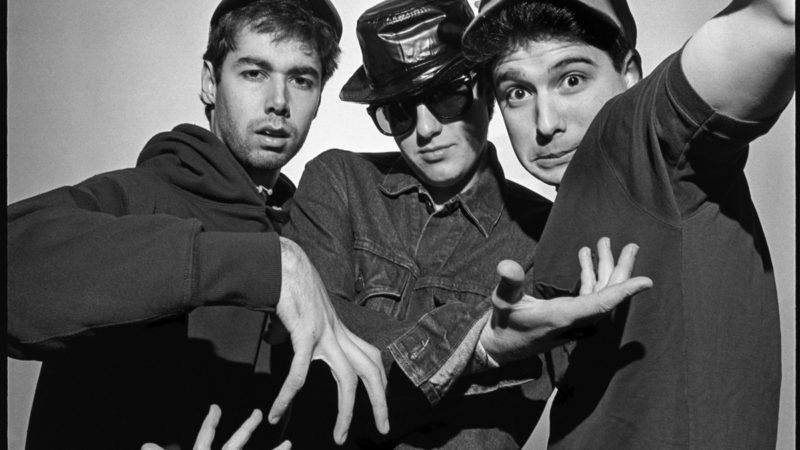Review: Beastie Boys Story
Ad-Rock and Mike D. remember.

One night back in the '80s—1987, maybe, in the Beastie Boys' delirious heyday—I was at one of those record-industry parties at which people stand around struggling to balance drinks and finger foods while pop stars pass through the crush, accumulating congratulations on their latest album or whatever has prompted this corporate gathering. I was watching a woman in a big fancy fur coat making her way across the room when suddenly the Beastie Boys themselves— "Ad-Rock" (Adam Horovitz), "Mike D" (Michael Diamond) and "MCA" (Adam Yauch)—swarmed around her in demented fashion and one of them poured a beer over her head. Those were the days…although maybe not for women in big fancy fur coats.
In Beastie Boys Story, the new documentary directed by longtime Beasties collaborator Spike Jonze, now airing on Apple TV+, Michael Diamond looks back on that dissolute period with a mixture of fondness and mild regret. "Our big idea was that we should be as rude and as awful onstage as possible," he says. "We'd be memorable—memorable fuckin' jerks." Jonze's film is a chronicle of how the Beasties' party-monster stage act took over their lives and how they eventually managed to outgrow it.
This is not a story that will be entirely new to fans (or to anyone who owns the 2018 Beastie Boys Book). But the film format lends it an engaging freshness. The picture captures a near-two-hour multimedia stage show, filmed at Brooklyn's venerable King's Theatre, in which surviving Beasties Diamond and Horovitz (Yauch died of cancer in 2012) pace the stage like the b-boy elders they are, recounting their rap-to-riches journey with the aid of vintage photos, film clips, and of course resoundingly big beats. It all feels very loose and breezy, although the show has been painstakingly written and rehearsed by Horovitz, Diamond and Jonze.
Launching the story, Diamond remembers being turned on to the Clash in 1981, then hooking up with bassist Adam Yauch at a Bad Brains gig and starting a band that included downtown pal Kate Schellenbach on drums, with Diamond as lead singer. Horovitz stepped in on guitar soon after and the group set up as a hardcore-punk unit (although, as Horovitz notes, "We were as much Monty Python as Black Flag").
The movie is naturally filled with early '80s rap atmosphere and namechecks: T La Rock, Run-DMC, Kurtis Blow, Whodini. In one film clip we see the godlike Afrika Bambaataa rendering judgment on the Beasties' first indie single, "Cooky Puss." ("It's funky," he says.) The group decides it needs a DJ for live gigs, so they approach a bearish New York University student named Rick Rubin—who, despite being a metal head and a pro-wrestling fan, owned a ton of DJing equipment (and a bubble machine) and was an aspiring producer, too. (The Beasties came to be inspired by his production philosophy: Who needs a band, Rubin figured, when you can make records with just a drum machine and a few samples. "It was raw and punk," Diamond says, admiringly.)
The Beasties opened up for Madonna on her first tour in 1985 (a gig they snagged mainly because they were willing to do it for $500). Her fans hated them without exception. Then they discovered the Roland TR-808, a programmable drum machine, and that, says Horovitz, changed everything: "We found our voice." Next came the world-conquering debut album, Licensed to Ill, and its attendant hit singles ("No Sleep till Brooklyn," "[You Gotta] Fight for Your Right [To Party!]," etc.). But Rubin's Def Jam label ground the band down with constant touring, and they felt themselves turning into clichés. Yauch, who had developed interests in filmmaking and Buddhism, pronounced himself tired of being "the drunk guy at the party." "We missed being the people we used to be," Horovitz says.
After drifting in new directions for a while (Horovitz tried acting, Diamond pursued an interest in drugs), the group reassembled in LA to record its second album, Paul's Boutique, which was released to the sound of crickets. They discovered they had gone broke, had to start over, then made a major return with the 1994 Ill Communication, which featured the terrific "Sabotage." The Beasties were back.
Eventually, the group ended its eight-year Los Angeles residency and returned to New York. Here the film takes on an elegiac tone, with Horovitz and Diamond expressing various regrets—especially their treatment of original drummer Kate Schellenbach, who was cast out of the group because of her inability to be a snotty young guy. ("It's shitty the way it all went down," says Horovitz.) Then comes the end—the 2009 Bonnaroo Festival, where the Beastie Boys played what turned out to be their last show. Three years later, Adam Yauch was dead and the band was over. You can feel Horovitz trying not to choke up at this point. Maybe yourself too.


Show Comments (5)